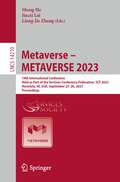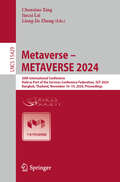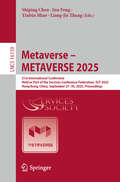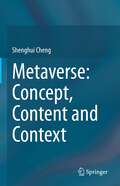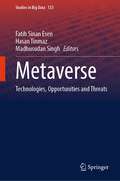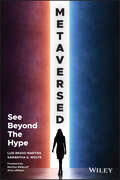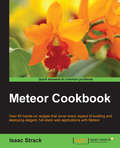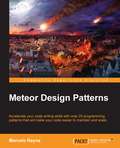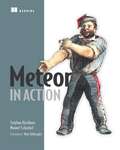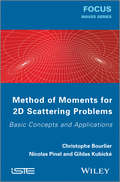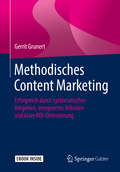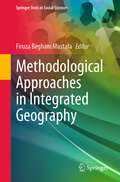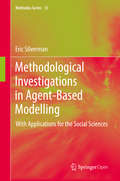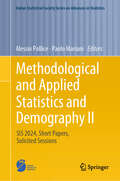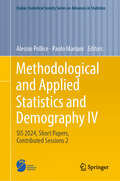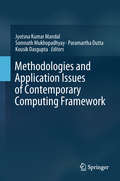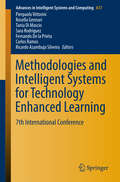- Table View
- List View
Metaverse – METAVERSE 2023: 19th International Conference, Held as Part of the Services Conference Federation, SCF 2023, Honolulu, HI, USA, September 23–26, 2023, Proceedings (Lecture Notes in Computer Science #14210)
by Liang-Jie Zhang Sheng He Jiacai LaiThis book constitutes the refereed proceedings of the 19th International Conference on Metaverse, METAVERSE 2023, held in Honolulu, HI, USA, during September 23–26, 2023.The 9 full papers and 3 short papers included in this book were carefully reviewed and selected from 15 submissions. They were organized in topical sections as follows: answer set programming; metaverse engineering foundations and applications, with a focus on novel approaches for engineering requirements, design and architectures, testing, maintenance and evolution, model-driven development, software processes, metrics, quality assurance and new software economics models, search-based software engineering, benefiting day-to-day services sectors and derived through experiences, with appreciation to scale, pragmatism, transparency, compliance and/or dependability.
Metaverse – METAVERSE 2024: 20th International Conference, Held as Part of the Services Conference Federation, SCF 2024, Bangkok, Thailand, November 16-19, 2024, Proceedings (Lecture Notes in Computer Science #15429)
by Chunxiao Xing Liang-Jie Zhang Jiacai LaiThis book constitutes the refereed proceedings of the 20th International Conference on Metaverse – METAVERSE 2024, held in Bangkok, Thailand, during November 16–19, 2024. The 6 full papers and 4 short papers included in this book were carefully reviewed and selected from 22 submissions. They were organized in topical sections as follows: research track; application and industry track; and short paper track.
Metaverse – METAVERSE 2025: 21st International Conference, Held as Part of the Services Conference Federation, SCF 2025, Hong Kong, China, September 27–30, 2025, Proceedings (Lecture Notes in Computer Science #16159)
by Jun Feng Liang-Jie Zhang Shiping Chen Yinbin MiaoThis book constitutes the refereed proceedings of the 21st International Conference on Metaverse – METAVERSE 2025, held in Hong Kong, China during September 27–30, 2025. The 8 full papers and one short paper included in this book were carefully reviewed and selected from 11 submissions. The papers focus on new work in various aspects of vertical industry services and related technologies and applications.
Metaverse: Concept, Content and Context
by Shenghui ChengThe metaverse, a hybrid society of the real and the virtual is attracting significant attention from academia to industry and is starting to change the world. Composed of ten chapters, this book introduces the metaverse from three aspects – concept, content and context. It starts with numerous concepts related to the metaverse, such as virtual reality, augmented reality, Web 3.0 and NFTs and describes the background, features, advantages and disadvantages. It then presents the content or key techniques around the metaverse, Artificial Intelligence, big data, edge computing, 3D modeling and blockchain. For each technique, it depicts how it performs to advance the development of the metaverse. Finally, it gives the context of the metaverse and illustrates the new society in the virtual world, consisting of economic systems, assets, social activities, security, law, etcetera. Overall, Metaverse: Concept, Content and Context provides a panoramic view of the metaverse, a key feature of which is the intuitive visualizations with numerous figures that clearly address the main aspects. This book is well-designed and well-written and will appeal to beginners and students as well as professionals, welcome to the metaverse community!
Metaverse: Technologies, Opportunities and Threats (Studies in Big Data #133)
by Madhusudan Singh Fatih Sinan Esen Hasan TinmazThis book has a multidisciplinary approach to Metaverse studies and the relevance of Metaverse with the current and popular topics that concern society and how it will change them in the future. In addition, academic texts are included since not much scientific content is available in this field. In short, there are sections in the book that everyone will find useful. Most importantly, the topics are grouped under four main parts. The first is the Introduction, where the main issues are explained. In the second section—Technical Topics, the technological infrastructure of the subject is explained, followed by section three where the social and human dimensions of Metaverse are explained. The fourth and final section is on Industrial Applications.
Metaverse: The fusion of reality and virtuality in the Next Generation Internet
by Peter HoffmannThe development of the Internet, particularly the World Wide Web, is currently reaching its limits – both technically and in socio-cultural and economic terms. As a solution, a new form of the Internet is being promised: one that aims to overcome the boundaries between the real and virtual worlds and merge reality with digitality – the metaverse. Technical, semantic, and organizational aspects are closely intertwined in this vision. But what does this mean upon closer examination? What technological and engineering challenges must be overcome to enable such a fusion? What economic opportunities arise – and which ones might be off-limits? How can we ensure the creation of an open and universally accessible metaverse? And how can we prevent a scenario in which a few large providers impose their proprietary visions on this new space? This book aims to provide answers to these questions. In the current edition, recent trends and the role of artificial intelligence in the metaverse have also been added.
Metaversed: See Beyond The Hype
by Samantha G. Wolfe Luis Bravo MartinsUnderstand the coming metaverse—and discover how to look past the hype and harness the future of technology. Metaversed is an insightful discussion and analysis of the next, rapidly approaching technological revolution. The authors deliver a compelling new exploration of how the metaverse and emerging technologies combine to define our collective future. In addition to identifying the business opportunities, the book pulls back the curtain on major safety and privacy issues that will arise and the expected shifts in both our private and social spheres. In the book, you’ll understand: How multiple industries will be changed and challenged in a 3D spatial world and how to navigate the future crypto-ladden business landscape; Legal and policy considerations necessary to build and maintain safe, shared digital spaces The economic and social impacts, including the potential for our digital lives to outlive our physical selves Actionable insights, so you can make the most out of the next digital revolution Metaversed is a can’t-miss presentation of the most significant market opportunities and societal challenges posed by the metaverse. It also will empower readers to take positive action that avoids the same online mistakes that happened on social media and create more responsible tech usage habits in our personal and professional lives.
Metaverso y Cripto para principiantes
by Adidas WilsonAparentemente los blockchain se harán cargo de la mayoría de los aspectos que rigen el mundo de las finanzas, y probablemente se convertirán en un hito para avanzar en las instituciones financieras y otros aspectos de la industria. Lo primero y más importante sobre el blockchain son sus características técnicas, que permiten transacciones entre personas anónimas, a la vez que hace que el sistema sea seguro para todos. Mejor aún, como el sistema no está sujeto a regulaciones por parte de bancos o gobiernos, ofrece una influencia sin precedentes para los usuarios por sobre la mayoría de los demás servicios financieros. El término metaverso fue usado por primera vez en una novela de ciencia ficción de 1992 llamada Snow Crash. Retrataba a los humanos como avatares que interactuaban entre sí y con agentes de software, que la cadena HBO está buscando producir en formato serie de televisión. En una explicación más detallada, el metaverso combina tecnologías que incluyen realidad virtual, que consiste en una comunidad en línea en la cual los usuarios interactúan entre sí en un mundo simulado de realidad aumentada que combina tanto el mundo físico como el digital.
Metaversum: Die Verschmelzung von Realität und Virtualität im Next Generation Internet
by Peter HoffmannDie Entwicklung des Internets, insbesondere des WWW, stößt aktuell an ihre Grenzen – sowohl technisch als auch sozio-kulturell und ökonomisch. Als Lösung wird ein neues Internet versprochen, das die Grenzen der realen und der virtuellen Welt überwinden und Realität und Digitalität verschmelzen soll – das Metaversum. Technische, semantische und organisatorische Details greifen hierzu eng ineinander. Was aber bedeutet dies bei genauerer Betrachtung? Welche technisch-technologischen Herausforderungen müssen bewältigt werden, um ein solches Verschmelzen zu erreichen? Welche ökonomischen Möglichkeiten eröffnen sich– und welche verbieten sich möglicherweise? Wie kann erreicht werden, dass ein offenes und für jeden benutzbares Metaversum entsteht? Und wie kann vermieden werden, dass auch in diesem neuen Metaversum wenige große Anbieter ihre proprietären Ideen durchsetzen? Für diese Fragen soll dieses Buch Antworten aufzeigen. In der vorliegenden Auflage wurden zudem aktuelle Trends sowie der Beitrag der künstlichen Intelligenz zum Metaversum ergänzt.
Meteor Cookbook
by Isaac StrackThis book is meant for developers of all experience levels looking to create mobile and full-stack web applications in JavaScript. Many of the simple recipes can easily be followed by less-experienced developers, while some of the advanced recipes will require extensive knowledge of existing web, mobile, and server technologies. Any application or enterprise web developer looking to create full-stack JavaScript-based apps will benefit from the recipes and concepts covered in this book.
Meteor Design Patterns
by Marcelo ReynaAccelerate your code writing skills with over twenty programming patterns that will make your code easier to maintain and scaleAbout This BookOptimize your web application for production useBuild views and controllers with minimal effort that will evolve with your applicationLearn how to maintain a MeteorJS project while it is running in productionWho This Book Is ForThis book is for developers who have already had an introductory course with Meteor. Basic knowledge of web development is recommended.What You Will LearnUse of Jade, Stylus, and CoffeeScript to speed up web developmentIncrease productivity by leveraging the best packages in the communityOptimize your site for load speed with advanced publishers and subscribersLeverage the aggregation framework to produce results with big dataMaster the intricacies of front-end development using Jeet, Bootstrap, CSS animations, and moreOptimize your site for search engine visibilitySecure your site with Meteor's best practicesTrack the live status of your application, ensuring all errors have been taken care ofIn DetailWith the increasing interest in NodeJS web applications, a new framework, Meteor, has joined the ranks to simplify developer workflows. Meteor is one of the few open source frameworks that has received funding since its early development stages. It builds on ideas from existing frameworks and libraries, offering developers an easy way to develop a prototype app. At the same time, it gives them the tools and flexibility to build a fully fledged production app. Meteor is the weapon of choice for start-ups in today's world.Meteor Design Patterns cuts through the jargon that most websites play with and gets to the point with simple solutions that will boost your development skills.We start off with a refresher on the basics of JavaScript programming such as templates, CoffeeScript, the Event Loop, and the Merge Box, amongst others. You then learn how to map real-world data and optimize the data's publishers to output data with the least amount of work done by the server with some subscribe and publish patterns. Next, using front-end patterns, you will learn how to create maintainable and trackable forms, and make our site crawlable by any search engine. Following this, you will see how to optimize and secure the web application and maintain applications without breaking other features. Finally, you will learn how to deploy a secure production-ready application while learning to set up modulus, compose with Oplog tracking and SSL certificates, as well as error tracking with Kadira.Throughout the book, you will put your skills to practice and build an online shop from scratch. By the end of the book, you will have built a feature-rich online shop.Style and approachThe book is a practical handbook on how to build an e-commerce web app using Meteor. Every topic ties into the webapp to easily illustrate the concepts that you are learning about.
Meteor in Action
by Stephan Hochhaus Manuel SchoebelSummaryMeteor in Action teaches you full-stack web development using the Meteor platform. It starts with an overview of a Meteor application, revealing the unique nature of Meteor's end-to-end application model. Then you'll dive into the Blaze templating engine, discover Meteor's reactive data sources model, learn simple and advanced routing techniques, and practice managing users, permissions, and roles. Purchase of the print book includes a free eBook in PDF, Kindle, and ePub formats from Manning Publications.About the BookYou might call Meteor a reactive, isomorphic, full-stack web development framework. Or, like most developers who have tried it, you might just call it awesome. Meteor is a JavaScript-based framework for both client and server web and mobile applications. Meteor applications react to changes in data instantly, so you get impossibly responsive user experiences, and the consistent build process, unified front- and back-end package system, and one-command deploys save you time at every step from design to release.Meteor in Action teaches you full-stack web development with Meteor. It starts by revealing the unique nature of Meteo's end-to-end application model. Through real-world scenarios, you'll dive into the Blaze templating engine, discover Meteor's reactive data sources model, learn routing techniques, and practice managing users, permissions, and roles. Finally, you'll learn how to deploy Meteor on your server and scale efficiently.What's InsideBuilding your first real-time applicationUsing MongoDB and other reactive data sourcesCreating applications with Iron RouterDeploying and scaling your applicationsAbout the ReaderReaders need to know the basics of JavaScript and understand general web application design.About the AuthorsStephan Hochhaus and Manuel Schoebel are veteran web developers who have worked with Meteor since its infancy.Table of ContentsPART 1 LOOK—A SHOOTING STAR!A better way to build appsMy fridge! A reactive gamePART 2 3, 2, 1—IMPACT!Working with templatesWorking with dataFully reactive editingUsers, authentications, and permissionsExchanging dataRouting using Iron.RouterThe package systemAdvanced server methodsPART 3 LEAVING THE CRATERBuilding and debuggingGoing into production
Meteor: Full-Stack Web Application Development
by Isaac Strack Fabian Vogelsteller Marcelo ReynaLearn how to create mobile and full-stack web applications in JavaScript by getting a deeper insight into Meteor About This Book * This step-by-step tutorial will show you how to build fast, complex web applications * Over 65 hands-on recipes help you build and deploy elegant web applications * Optimize your web application for production use Who This Book Is For If you are a web developer who is familiar with Meteor and has basic knowledge of web development, and you now want to explore new paradigms of single-page, real-time applications, this course is perfectly suited for you. What You Will Learn * Secure your site with Meteor best practices * Create reactive templates that update themselves when data changes * Add routing to a single-page application and make it appear like a real website * Make your own Meteor packages and see how to make them public * Rapidly build robust, responsive user interfaces * Publish your own reusable custom packages * Optimize your site for load speed with advanced publishers and subscribers * Master the intricacies of front-end development using Jeet, Bootstrap, CSS animations, and more * Leverage the aggregation framework to produce results with big data * Optimize your site for search engine visibility In Detail Meteor is best JavaScript development platform and is packed with collections of libraries and packages bound together in a tidy way to take care of everything from development to production, making your web development easier. This course follows a learning path divided into three modules. Each module is a mini course in its own right, taking your knowledge to a new level as you progress. The first module takes you from the installation of Meteor to building a fully working web blog (including back end) to create and edit posts. Your path will begin with the basic concepts and folder structure of a Meteor project, learning how Meteor templates work to test packages, and seeing the application itself. The second module is a cookbook that starts with simple recipes designed for quick reference, and culminating advanced recipes that walk you through building and deploying a complete application. The cookbook covers all the major areas of Meteor development, including lesser-known and undocumented features too. With all the important concepts covered in the previous modules, the third module will get you equipped with simple solutions to boost your development skills. You'll learn about mapping of real-world data and optimizing it, how to optimize and secure web applications and how to deploy and maintain it without breaking its features. Throughout the module, you will put your skills into practice and build an online shop from scratch. This Learning Path combines some of the best that Packt has to offer in one complete, curated package. It includes content from the following Packt products: * Building Single-page Web Apps with Meteor, Fabian Vogelsteller * Meteor Cookbook, Isaac Strack * Meteor Design Patterns, Marcelo Reyna Style and approach This practical handbook has a step-by-step approach to help you improve your developer skills and efficiently built web applications using Meteor.
Method of Moments for 2D Scattering Problems: Basic Concepts and Applications
by Nicolas Pinel Christophe Bourlier Gildas KubickéElectromagnetic wave scattering from randomly rough surfaces in the presence of scatterers is an active, interdisciplinary area of research with myriad practical applications in fields such as optics, acoustics, geoscience and remote sensing. In this book, the Method of Moments (MoM) is applied to compute the field scattered by scatterers such as canonical objects (cylinder or plate) or a randomly rough surface, and also by an object above or below a random rough surface. Since the problem is considered to be 2D, the integral equations (IEs) are scalar and only the TE (transverse electric) and TM (transverse magnetic) polarizations are addressed (no cross-polarizations occur). In Chapter 1, the MoM is applied to convert the IEs into a linear system, while Chapter 2 compares the MoM with the exact solution of the field scattered by a cylinder in free space, and with the Physical Optics (PO) approximation for the scattering from a plate in free space. Chapter 3 presents numerical results, obtained from the MoM, of the coherent and incoherent intensities scattered by a random rough surface and an object below a random rough surface. The final chapter presents the same results as in Chapter 3, but for an object above a random rough surface. In these last two chapters, the coupling between the two scatterers is also studied in detail by inverting the impedance matrix by blocks. Contents 1. Integral Equations for a Single Scatterer: Method of Moments and Rough Surfaces. 2. Validation of the Method of Moments for a Single Scatterer. 3. Scattering from Two Illuminated Scatterers. 4. Scattering from Two Scatterers Where Only One is Illuminated. Appendix. Matlab Codes. About the Authors Christophe Bourlier works at the IETR (Institut d’Electronique et de Télécommunications de Rennes) laboratory at Polytech Nantes (University of Nantes, France) as well as being a Researcher at the French National Center for Scientific Research (CNRS) on electromagnetic wave scattering from rough surfaces and objects for remote sensing applications and radar signatures. He is the author of more than 160 journal articles and conference papers. Nicolas Pinel is currently working as a Research Engineer at the IETR laboratory at Polytech Nantes and is about to join Alyotech Technologies in Rennes, France. His research interests are in the areas of radar and optical remote sensing, scattering and propagation. In particular, he works on asymptotic methods of electromagnetic wave scattering from random rough surfaces and layers. Gildas Kubické is in charge of the “Expertise in electroMagnetism and Computation” (EMC) laboratory at the DGA (Direction Générale de l’Armement), French Ministry of Defense, where he works in the field of radar signatures and electromagnetic stealth. His research interests include electromagnetic scattering and radar cross-section modeling.
Methoden des bestärkenden Lernens für die Produktionsablaufplanung
by Sebastian LangIn diesem Open-Access-Buch wird eine Methode zur Adaption, Integration und Anwendung von bestärkenden Lernverfahren (Reinforcement Learning) für die Produktionsablaufplanung beschrieben. Die Methode wird anhand von typischen Problemstellungen der Produktionsablaufplanung hergeleitet und evaluiert. Die Produktionsablaufplanung ist eine Kernaufgabe der Produktion und Logistik, bei welcher Aufträge auf Ressourcen so verteilt und in Reihenfolge gebracht werden müssen, dass geforderte Nebenbedingungen der Planung erfüllt werden. Entsprechende Optimierungsprobleme sind meist NP-schwer, wodurch eine optimale Lösung gewöhnlich nicht unter wirtschaftlichen Bedingungen erzielbar ist. In der Industrie werden stattdessen Prioritätsregeln, Heuristiken oder Metaheuristiken verwendet, die entweder zeiteffizient zu Lasten der Lösungsgüte rechnen oder qualitativ hochwertige Lösungen unter hohem Rechenaufwand erzeugen. Das bestärkende Lernen ist eine Unterart des maschinellen Lernens und eine weitere Klasse potenzieller Lösungsstrategien. Probleme der Produktionsablaufplanung sind insoweit vergleichbar, als dass sie sich ebenfalls als stufenartige Entscheidungsketten modellieren lassen. Trotz ihrer Vorteile existiert bisher kaum allgemeines Wissen hinsichtlich der Anwendung des bestärkenden Lernens für die Produktionsablaufplanung.
Methodisches Content Marketing: Erfolgreich durch systematisches Vorgehen, integriertes Arbeiten und klare ROI-Orientierung
by Gerrit GrunertDieses Buch vermittelt, wie Sie Content-Marketing-Strategien Schritt für Schritt in Ihrem Unternehmen implementierenIn seinem Buch „Content Marketing mit System“ vermittelt Autor Gerrit Grunert Unternehmern und Marketern die wichtigsten Strategien und Methoden des Content Marketings. Er widmet sich hierfür allen Dimensionen der Marketing-Disziplin – von der Planung über die Konzeption bis zur Content Distribution. Die übersichtliche Darstellung und konkrete Praxisbeispiele tragen dazu bei, dass der Inhalt leicht verständlich ist.Wichtige Tools und Messgrößen für Ihren UnternehmenserfolgGerrit Grunert gelingt es mit seinem Buch aber nicht nur, die wichtigsten Methoden und Strategien im Content Marketing praxisorientiert zu vermitteln, indem er die verschiedenen Einzeldisziplinen und deren Ziele vorstellt. Mit seinem Werk gibt er Ihnen zusätzlich eine Toolbox voller nützlicher Werkzeuge an die Hand, die Ihnen dabei helfen, Content Marketing in Ihrem Unternehmen effizient umzusetzen. (131)
Methodological Approaches in Integrated Geography (Springer Texts in Social Sciences)
by Firuza Begham MustafaThis book covers methodology of the study for all aspects of human geography. As a comprehensive geography textbook, it consists of detailed research methodology for research in human geography including a few selected case studies in Asia. It explores different approaches, methodological possibilities, and challenges in conducting geographical research in human geography. New digital geographic data sources and GIS applications can help researchers to receive clearer concepts and obtain better measurements of the relevant attributes changes. Furthermore, the book provides an opportunity to critically examine the conceptualization and identification of the field in geographical research and how digital media has not only expanded the scope of what constitutes the field but has redefined the field in itself as well as the practices of observing, knowing, and analyzing the real world. The uniqueness of this book is due to the contribution of several professors and subject experts from South East and East Asia with special particular reference to cases studies from this region of the world.
Methodological Investigations in Agent-Based Modelling: With Applications For The Social Sciences (Methodos Ser. #13)
by Daniel Courgeau Jakub Bijak John Bryden Eric Silverman Robert Franck Jason Hilton Jason NobleThis open access book examines the methodological complications of using complexity science concepts within the social science domain. The opening chapters take the reader on a tour through the development of simulation methodologies in the fields of artificial life and population biology, then demonstrates the growing popularity and relevance of these methods in the social sciences. Following an in-depth analysis of the potential impact of these methods on social science and social theory, the text provides substantive examples of the application of agent-based models in the field of demography. This work offers a unique combination of applied simulation work and substantive, in-depth philosophical analysis, and as such has potential appeal for specialist social scientists, complex systems scientists, and philosophers of science interested in the methodology of simulation and the practice of interdisciplinary computing research.
Methodological and Applied Statistics and Demography I: SIS 2024, Short Papers, Plenary and Specialized Sessions (Italian Statistical Society Series on Advances in Statistics)
by Paolo Mariani Alessio PolliceThis book of peer-reviewed short papers on methodological and applied statistics and demography is the first of four volumes from the 52nd Scientific Meeting of the Italian Statistical Society (SIS 2024), held in Bari, Italy, on June 17-20, 2024. It features invited contributions presented in the Plenary and Specialized Sessions. The volumes address a large number of topics and applications of current interest. The topics covered include, but are not limited to, statistical theory and methods, sampling theory, Bayesian statistics, statistical modeling, computational statistics, classification, data analysis, gender statistics and applied statistics. The applications reflect new analyses in a wide variety of fields, including demography, psychometrics, education, business, economics, finance, law, and other social sciences and humanities, epidemiology, the life and health sciences as well as the environmental and natural sciences and engineering. This variety also demonstrates the important role of statistical science in addressing the societal and environmental challenges of sustainable development. One of the aims of the Italian Statistical Society (SIS) is to promote scientific activities for the development of statistical sciences. Its biennial international Scientific Meeting represents the Society’s largest event which brings together national and international researchers and professionals to exchange ideas and discuss recent advances and developments in theoretical and applied statistics.
Methodological and Applied Statistics and Demography II: SIS 2024, Short Papers, Solicited Sessions (Italian Statistical Society Series on Advances in Statistics)
by Paolo Mariani Alessio PolliceThis book of peer-reviewed short papers on methodological and applied statistics and demography is the second of four volumes from the 52nd Scientific Meeting of the Italian Statistical Society (SIS 2024), held in Bari, Italy, on June 17-20, 2024. It features invited contributions presented in the Solicited Sessions. The volumes address a large number of topics and applications of current interest. The topics covered include, but are not limited to, statistical theory and methods, sampling theory, Bayesian statistics, statistical modeling, computational statistics, classification, data analysis, gender statistics and applied statistics. The applications reflect new analyses in a wide variety of fields, including demography, psychometrics, education, business, economics, finance, law, and other social sciences and humanities, epidemiology, the life and health sciences as well as the environmental and natural sciences and engineering. This variety also demonstrates the important role of statistical science in addressing the societal and environmental challenges of sustainable development. One of the aims of the Italian Statistical Society (SIS) is to promote scientific activities for the development of statistical sciences. Its biennial international Scientific Meeting represents the Society’s largest event which brings together national and international researchers and professionals to exchange ideas and discuss recent advances and developments in theoretical and applied statistics.
Methodological and Applied Statistics and Demography III: SIS 2024, Short Papers, Contributed Sessions 1 (Italian Statistical Society Series on Advances in Statistics)
by Paolo Mariani Alessio PolliceThis book of peer-reviewed short papers on methodological and applied statistics and demography is the third of four volumes from the 52nd Scientific Meeting of the Italian Statistical Society (SIS 2024), held in Bari, Italy, on June 17-20, 2024. It features the first part of the contributions presented in the Contributed Sessions. The volumes address a large number of topics and applications of current interest. The topics covered include, but are not limited to, statistical theory and methods, sampling theory, Bayesian statistics, statistical modeling, computational statistics, classification, data analysis, gender statistics and applied statistics. The applications reflect new analyses in a wide variety of fields, including demography, psychometrics, education, business, economics, finance, law, and other social sciences and humanities, epidemiology, the life and health sciences as well as the environmental and natural sciences and engineering. This variety also demonstrates the important role of statistical science in addressing the societal and environmental challenges of sustainable development. One of the aims of the Italian Statistical Society (SIS) is to promote scientific activities for the development of statistical sciences. Its biennial international Scientific Meeting represents the Society’s largest event which brings together national and international researchers and professionals to exchange ideas and discuss recent advances and developments in theoretical and applied statistics.
Methodological and Applied Statistics and Demography IV: SIS 2024, Short Papers, Contributed Sessions 2 (Italian Statistical Society Series on Advances in Statistics)
by Paolo Mariani Alessio PolliceThis book of peer-reviewed short papers on methodological and applied statistics and demography is the fourth of four volumes from the 52nd Scientific Meeting of the Italian Statistical Society (SIS 2024), held in Bari, Italy, on June 17-20, 2024. It features the second part of the contributions presented in the Contributed Sessions. The volumes address a large number of topics and applications of current interest. The topics covered include, but are not limited to, statistical theory and methods, sampling theory, Bayesian statistics, statistical modeling, computational statistics, classification, data analysis, gender statistics and applied statistics. The applications reflect new analyses in a wide variety of fields, including demography, psychometrics, education, business, economics, finance, law, and other social sciences and humanities, epidemiology, the life and health sciences as well as the environmental and natural sciences and engineering. This variety also demonstrates the important role of statistical science in addressing the societal and environmental challenges of sustainable development. One of the aims of the Italian Statistical Society (SIS) is to promote scientific activities for the development of statistical sciences. Its biennial international Scientific Meeting represents the Society’s largest event which brings together national and international researchers and professionals to exchange ideas and discuss recent advances and developments in theoretical and applied statistics.
Methodologies and Application Issues of Contemporary Computing Framework
by Paramartha Dutta Jyotsna Kumar Mandal Somnath Mukhopadhyay Kousik DasguptaThis book brings together the diversified areas of contemporary computing frameworks in the field of Computer Science, Engineering and Electronic Science. It focuses on various techniques and applications pertaining to cloud overhead, cloud infrastructure, high speed VLSI circuits, virtual machines, wireless and sensor networks, clustering and extraction of information from images and analysis of e-mail texts. The state-of-the-art methodologies and techniques are addressed in chapters presenting various proposals for enhanced outcomes and performances. The techniques discussed are useful for young researchers, budding engineers and industry professionals for applications in their respective fields.
Methodologies and Intelligent Systems for Technology Enhanced Learning
by Rosella Gennari Pierpaolo Vittorini Tania Di Mascio Sara Rodríguez Fernando De la Prieta Carlos Ramos Ricardo Azambuja SilveiraThis book presents the outcomes of the 7th International Conference in Methodologies and Intelligent Systems for Technology Enhanced Learning (MIS4TEL'17), hosted by the Polytechnic of Porto, Portugal from 21 to 23 June 2017. Expanding on the topics of the previous conferences, it provided an open forum for discussing intelligent systems for technology enhanced learning (TEL) and their roots in novel learning theories, empirical methodologies for their design or evaluation, stand-alone and web-based solutions, and makerspaces. It also fostered entrepreneurship and business startup ideas, bringing together researchers and developers from industry, education and the academic world to report on the latest scientific research, technical advances and methodologies.
Methodologies and Intelligent Systems for Technology Enhanced Learning, 10th International Conference (Advances in Intelligent Systems and Computing #1241)
by Marco Temperini Rosella Gennari Pierpaolo Vittorini Tania Di Mascio Fernando De la Prieta Laura TarantinoThis book intends to bring together researchers and developers from industry, the education field, and the academic world to report on the latest scientific research, technical advances, and methodologies. The 10th International Conference in Methodologies and Intelligent Systems for Technology Enhanced Learning is hosted by the University of L’Aquila and is going to be held in L’Aquila (Italy). Initially planned on the 17th to the 19th of June 2020, it was postponed to the 7th to the 9th of October 2020, due to the COVID-19 outbreak. The 10th edition of this conference and its related workshops expand the topics of the evidence-based TEL workshops series in order to provide an open forum for discussing intelligent systems for TEL, their roots in novel learning theories, empirical methodologies for their design or evaluation, stand-alone solutions, or web-based ones. This bridge has been realized also thanks to the sponsor of this edition of MIS4TEL: the Armundia Group https://www.armundia.com, the support from national associations (AEPIA, APPIA, CINI, and EurAI), and organizers (UNIVAQ, UNIROMA1, UNIBZ, UCV, UFSC, USAL, AIR institute, UNC, and UNIBA)
